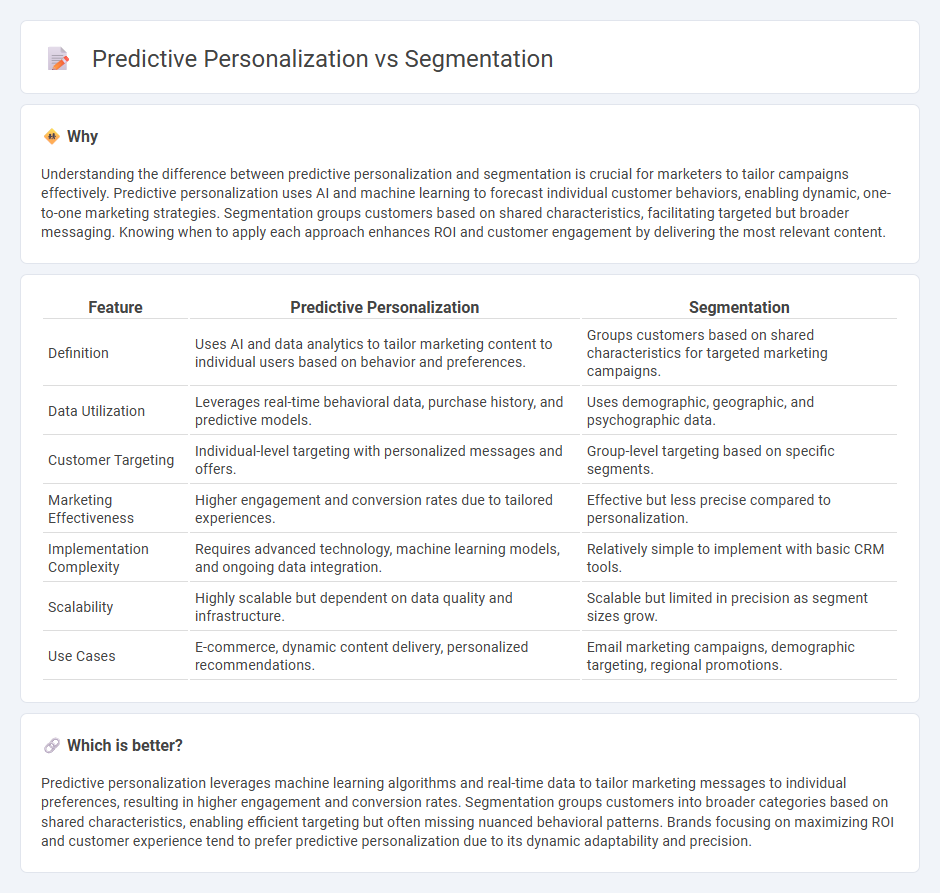
Predictive personalization leverages data analytics and machine learning to tailor marketing messages based on individual customer behavior, whereas segmentation groups customers into predefined categories for targeted campaigns. By analyzing real-time interactions, predictive personalization enhances customer engagement with highly relevant offers, surpassing the broad approach of traditional segmentation. Explore how integrating predictive personalization can transform your marketing strategy and drive higher conversion rates.
Why it is important
Understanding the difference between predictive personalization and segmentation is crucial for marketers to tailor campaigns effectively. Predictive personalization uses AI and machine learning to forecast individual customer behaviors, enabling dynamic, one-to-one marketing strategies. Segmentation groups customers based on shared characteristics, facilitating targeted but broader messaging. Knowing when to apply each approach enhances ROI and customer engagement by delivering the most relevant content.
Comparison Table
| Feature | Predictive Personalization | Segmentation |
|---|---|---|
| Definition | Uses AI and data analytics to tailor marketing content to individual users based on behavior and preferences. | Groups customers based on shared characteristics for targeted marketing campaigns. |
| Data Utilization | Leverages real-time behavioral data, purchase history, and predictive models. | Uses demographic, geographic, and psychographic data. |
| Customer Targeting | Individual-level targeting with personalized messages and offers. | Group-level targeting based on specific segments. |
| Marketing Effectiveness | Higher engagement and conversion rates due to tailored experiences. | Effective but less precise compared to personalization. |
| Implementation Complexity | Requires advanced technology, machine learning models, and ongoing data integration. | Relatively simple to implement with basic CRM tools. |
| Scalability | Highly scalable but dependent on data quality and infrastructure. | Scalable but limited in precision as segment sizes grow. |
| Use Cases | E-commerce, dynamic content delivery, personalized recommendations. | Email marketing campaigns, demographic targeting, regional promotions. |
Which is better?
Predictive personalization leverages machine learning algorithms and real-time data to tailor marketing messages to individual preferences, resulting in higher engagement and conversion rates. Segmentation groups customers into broader categories based on shared characteristics, enabling efficient targeting but often missing nuanced behavioral patterns. Brands focusing on maximizing ROI and customer experience tend to prefer predictive personalization due to its dynamic adaptability and precision.
Connection
Predictive personalization leverages data analytics and machine learning to forecast customer behavior, enabling marketers to tailor content and offers to individual preferences. Segmentation divides the audience into distinct groups based on demographics, behaviors, and psychographics, providing a structured framework for targeted marketing campaigns. The integration of predictive personalization within segmentation enhances marketing efficiency by delivering highly relevant messages that increase engagement and conversion rates.
Key Terms
Demographics
Segmentation based on demographics categorizes audiences into groups such as age, gender, income, and location to tailor marketing strategies effectively. Predictive personalization leverages demographic data combined with behavioral insights and machine learning algorithms to anticipate individual preferences and deliver customized experiences. Explore how integrating these approaches can enhance customer engagement and increase conversion rates.
Behavioral Data
Behavioral data-driven segmentation categorizes users based on actions such as browsing history, purchase frequency, and engagement patterns, enabling targeted marketing campaigns. Predictive personalization leverages machine learning algorithms to analyze this behavioral data and forecast future user preferences, offering tailored content and experiences. Explore more to understand how integrating these approaches can enhance customer engagement and conversion rates.
Machine Learning
Segmentation groups customers based on shared characteristics using machine learning algorithms like k-means clustering or hierarchical clustering to identify distinct market segments. Predictive personalization leverages advanced predictive models, including deep learning and gradient boosting, to tailor individual customer experiences by forecasting behaviors and preferences in real time. Explore the latest machine learning techniques to understand how these approaches transform marketing strategies.
Source and External Links
Market segmentation - Wikipedia - Market segmentation is the process of dividing a consumer or business market into meaningful sub-groups known as segments based on shared characteristics, allowing businesses to target those segments with distinct marketing strategies for better profitability and growth potential.
What is Segmentation? Definition & Examples - Vendasta - Segmentation is a marketing strategy that divides a large target audience into smaller, more specific groups based on shared demographics, psychographics, behavior, or geographic factors to create more effective and tailored marketing campaigns.
Mastering Your Market Segmentation Strategy: Tips and Examples - Market segmentation categorizes customers by shared demographic, psychographic, behavioral, or geographic traits to deliver targeted marketing strategies suited to the unique preferences and actions of each group.
 dowidth.com
dowidth.com